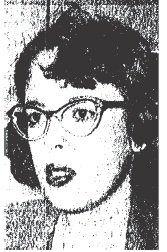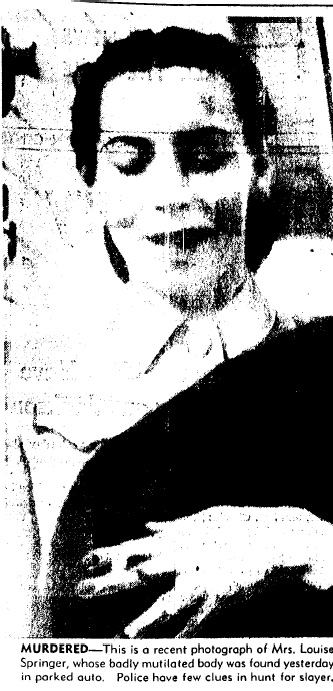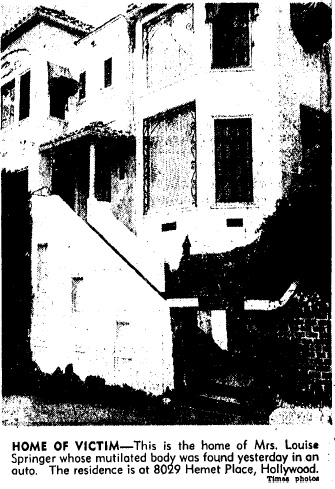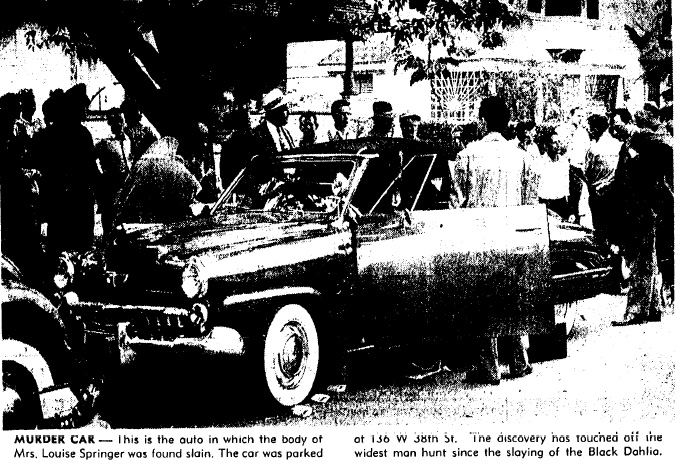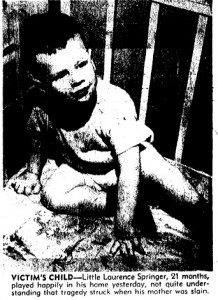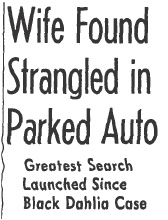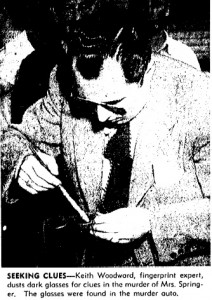 The biggest manhunt since the murder of Elizabeth Short continued as cops tried to find the killer of hairstylist Louise Springer.
The biggest manhunt since the murder of Elizabeth Short continued as cops tried to find the killer of hairstylist Louise Springer.
LAPD conjectured that either Louise Springer had been immediately stunned with a blunt instrument as she sat in her car at a Crenshaw Blvd. parking lot, or she had known the person who murdered her. The two possible theories were supported by the fact that Louise had apparently offered no resistance, nor had she cried out — and, tellingly, her brand new manicure was still pristine.
There were bruises on Louise’s right temple and the top of her head which, in the opinion of Dr. Frederick D. Newbarr, the autopsy surgeon, were hard enough to render her unconscious.
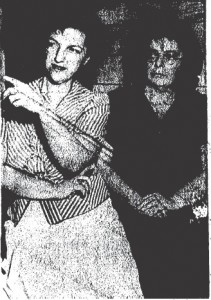
Mrs. Jewell Lorange, left, and Miss Germaine Le Gault presented possible clue to slaying of Mrs. Louise Springer in reporting “three men in black car.”
Of the scant leads uncovered by detectives, an interesting piece of information emerged. Miss Germaine Le Gault and Mrs. Jewell Lorange, who lived directly across from where the death car was found, said that they saw three men “in a big, black car” spend two evenings prior to the murder parked less than 50 feet away from where Springer’s strangled body was found. Unfortunately, the lead never panned out.
More than a week had passed when suddenly the Springer case began to heat up with the arrest of two suspects: Leon Russell, car washer at a service station near the parking lot, and Claud Cox, a jobless Navy vet who had been arrested on a morals complaint made by a young Hollywood woman named Marion Brown. Brown, 18, told cops that Claud Cox, whom she said she knew slightly, took her to his room at 1611 N. Orange Drive and tried to molest her. Cox told cops that he got “a little friendly” but he flatly denied trying to harm the girl.
As cops tracked down leads, Louise Springer’s husband and her 21 month old son mourned the wife and mother as she was laid to rest in a San Jose cemetery.
At least the crime lab was finally able to state conclusively that Louise Springer had not been slugged before she was garroted in her husband’s car. What had initially appeared to be bruises on Mrs. Springer’s head were actually post-mortem tissue changes — the result of the dead woman’s body resting face down for three days in the backseat of the car before being discovered. The evidence suggested that Springer had been murdered in the car, at the parking lot, as she listened to the radio.
Another suspect was arrested and cleared by LAPD homicide detectives. The man was thirty-eight year old Guy Smith who was busted by L.A. Sheriff’s department deputies on a tip from a relative. Nobody can do you dirt like family. In any case, Smith had an alibi for the time of Louise’s murder; however, the law was investigating him in connection with other unsolved crimes, notably morals offenses.
As the case grew colder the cops began to cast around for a new motive in Louise’s murder. Maybe kidnapping and sexual assault weren’t the real motives; maybe someone had a grudge against her, or they were jealous of the attractive brunette.
 One of the early suspects in Springer’s murder, Claude Cox, was arrested in September 1949, but the arrest had nothing to do with Louise Springer’s death. According to Mrs. Geneva Cowen, 35, she was walking along Hollywood Blvd. when she heard someone come up behind her. She turned and the man, Claude Cox, rushed up and hit her, hard. Cox said: “I’m going to kill you.” Cowen took a chance and started to run. Cox grabbed for her, but only succeeded in pulling her coat off.
One of the early suspects in Springer’s murder, Claude Cox, was arrested in September 1949, but the arrest had nothing to do with Louise Springer’s death. According to Mrs. Geneva Cowen, 35, she was walking along Hollywood Blvd. when she heard someone come up behind her. She turned and the man, Claude Cox, rushed up and hit her, hard. Cox said: “I’m going to kill you.” Cowen took a chance and started to run. Cox grabbed for her, but only succeeded in pulling her coat off.
Eventually the leads dried up and the Louise Springer murder, aka, the Green Twig Murder case, went cold.
Laurence and Louise Springer had been in L.A. for only six months before she was murdered, so the widower returned to Northern California to try to put some of his pain behind him.
The single major success in the case came when Dr. Mildred Mathias, UCLA botanist, was finally able to identify the twig that had been so cruelly inserted into Louise Springer’s vagina as belonging to a bottle tree. Dr. Mathias said that the twig had apparently been stripped from a larger branch sometime in the year prior to the crime.
Louise Springer’s murder remains unsolved.

